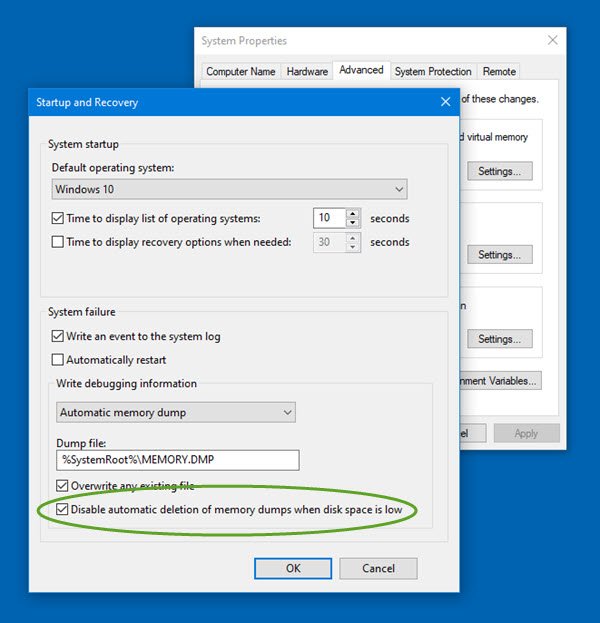In Windows 11/10/8, Microsoft includes a Memory dump option called Automatic Memory Dump. This is the default option set in the operating system. Windows 11/10 introduced a new dump file type called Active Memory Dump.
For those you don’t know, on Windows 7, we have Minidump, Kernel Dump, and Complete Memory Dump. You might be wondering why Microsoft chose to create this new Memory dump setting.
Well, according to Robert Simpkins, Senior Support Escalation Engineer, Automatic Memory Dump is to create support for “System Managed” page file configuration. The System Managed page file configuration is responsible for managing the page file size – therefore, it avoids over-sizing or under-sizing your page file. This option is introduced mainly for PCs that run SSDs, which tend to have a smaller size, but a huge amount of RAM.
Change Windows Memory Dump Settings
The main advantage of “Automatic Memory Dump” is that it will allow the Session Manager sub-system process to automatically allow it to reduce the Page file to a size smaller than the size of RAM. For those who don’t know, Session Manager Subsystem is responsible for initializing the system environment and starting up services and processes needed for users to log in. It basically sets up the page files for virtual memory and starts up the winlogon.exe process.
If you want to change Automatic Memory Dump Settings, here is how you can do it. Press Win + X and click on System. Next, click on “Advanced System Settings”.
Under Start up and Recovery, click on Settings.
There you can see a drop-down menu where it says “Write debugging information”.
Here you can select the option you want. The options offered are:
- No memory dumps
- Small memory dump
- Kernel memory dump
- Complete memory dump
- Automatic memory dump. Added in Windows 8.
- Active Memory Dump. Added in Windows 10.
The location of the Memory Dump file is at %SystemRoot%\MEMORY.DMP.
If you are using SSD, then it’s best to leave it at “Automatic Memory Dump”; but if you need a crash dump file, then it’s best to set it to “Small memory dump” as this way, you can, if you wish, send it to someone to take a look at.
TIP: You can analyze Windows Memory Dump .dmp files with WhoCrashed.
Increase Page file size to create a complete memory dump
In some cases, we may need to increase the page file size to more than that of the RAM to fit a complete memory dump. In such cases, we can create a registry key under
HKEY_LOCAL_MACHINE\SYSTEM\CurrentControlSet\Control\CrashControl
called “LastCrashTime”.
This will automatically increase the size of the page file. To reduce it, later on, you can delete the key.
Windows 11/10 includes a new dump file type called Active Memory Dump. It contains only the essentials and is, therefore, smaller in size.
Read: How to manually create a Crash Dump file in Windows 11/10.
Disable automatic deletion of memory dumps on low disk space

Windows will automatically delete dump files on low disk space. But if you wish to disable the automatic deletion of memory dumps on low disk space, then do this,
Open System Properties > Advanced tab > Startup and Recovery settings.
Under System failure, select Disable automatic deletion of memory dumps when disk space is low option, click OK, and exit.
Related reads:



I’m on Windows 8.1 and it does not save crash dumps. I enabled a page file (1-2GB), which is less than amount of RAM I have (32GB). The dump setting is ‘Automatic’.
I tested it with the Crash Dump Test utility in WhoCrashed, but it’s just stuck at 0% “We’re collecting info…”